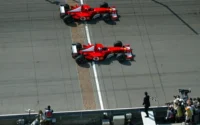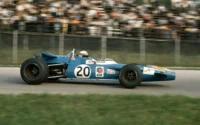Automobiles Gonfaronnaises Sportives, better known as AGS or Gonfaron Sports Cars, was a plucky French race car constructor that punched above its weight for more than thirty years. From humble village beginnings to the glitz (and grind) of Formula One between 1986 and 1991, AGS’s journey is one of underdog persistence. Even after its Formula One adventure ended, AGS lived on, thriving as a Formula One driving school in Le Luc, just a short drive from its birthplace in Gonfaron.
Foundation
The story begins with Henri Julien, a French mechanic and motorsport dreamer who ran a modest filling station called Garage de l’Avenir in the sleepy village of Gonfaron. In the late 1950s and early ’60s, Julien could often be found at small racing events, competing in minor classes. While he never made a name for himself as a driver, his deep technical curiosity and hands-on experience lit a spark that would lead him to design and build his own racing cars.
The First Car
Julien’s first creation, the AGS JH1, rolled out in 1969 — a petite single-seater built for the Formule France category. It was designed by Christian Vanderpleyn, a talented Belgian mechanic who had apprenticed under Julien in the late 1950s and would remain part of AGS’s story until 1988.
From these modest beginnings, AGS started crafting Formula 3 cars. Ambitious though they were, these early machines couldn’t quite topple the dominant Martinis of the era. Still, the seed was planted — and AGS was on its way up the ladder.
Formula 2
In 1978, AGS took a bold leap into the European Formula 2 Championship. Their car — the AGS JH15, designed and built entirely in-house by Vanderpleyn — embodied the team’s do-it-yourself spirit. Competing in 1978 and 1979, AGS failed to score points, but by the early 1980s things began to click.
Running their own chassis while rivals like Maurer, Minardi, and Merzario followed suit, AGS gradually started earning championship points — and eventually victories. The highlight came in 1984, when Philippe Streiff piloted the AGS JH19C to victory in the final Formula 2 race ever held. It was a historic moment for the little team from Gonfaron.
Formula 3000
When Formula 2 evolved into Formula 3000, AGS adapted once again. In 1985, they entered the new series with the AGS JH20, a car based on the Duqueine VG4 Formula 3 chassis and powered by a Cosworth DFV engine tuned by the Swiss firm Mader. Despite their enthusiasm, results were middling across 1985 and 1986 — but something far bigger was brewing.
Formula One
The Beginnings
By the summer of 1986, AGS made the audacious jump to Formula One, entering the Italian Grand Prix at Monza. The entire operation consisted of just seven employees, still working out of the same Garage de l’Avenir back in Gonfaron — making AGS the smallest team on the grid by far.
Their debut car, the AGS JH21C, was another Vanderpleyn design — a curious hybrid of old AGS F3000 machinery and recycled Renault F1 components. Power came from a second-hand Motori Moderni turbo engine, marking the only time these Carlo Chiti–developed units were supplied to a customer team. Italian driver Ivan Capelli took the wheel, though technical gremlins meant he never reached the finish line in either Italy or Portugal.
Before Capelli’s debut, the car was even tested at Paul Ricard by Didier Pironi, in what would have been his first Formula One drive since his career-ending crash at the 1982 German Grand Prix.
1987: First Full Season
For its first full campaign in 1987, AGS introduced the JH22 — still Vanderpleyn’s work, now powered by a normally aspirated Cosworth DFZ engine. Former AGS Formula 2 driver Pascal Fabre handled driving duties. He proved steady, finishing eight of his first nine races, though never close to the points.
Late in the year, Fabre was replaced by Roberto Moreno, a talented Brazilian finally getting another F1 chance after his failed Lotus outing in 1982. In Adelaide, Moreno brought AGS its first-ever World Championship point, putting the team level on the scoreboard with Ligier and March — both far better funded.
The De Rouvre Takeover
In 1988, AGS started fresh with the JH23 and its lone driver Philippe Streiff, who delivered strong qualifying performances and flashes of real pace. Unfortunately, reliability issues plagued the season — Streiff saw the chequered flag just four times.
Financially, the year began with promise. AGS had secured backing from Bouygues, the French industrial giant, to fund both the F1 effort and a brand-new factory near Gonfaron. But halfway through construction, Bouygues suddenly pulled out, leaving Julien in financial freefall. To keep the team alive, he sold it to businessman Cyril de Rouvre.
Struggles and Setbacks
The transition was turbulent. Management turnover was constant — even Vanderpleyn left, moving to Coloni — and stability became a distant dream. Then tragedy struck: Philippe Streiff suffered a devastating crash during testing in Brazil before the 1989 season, leaving him paralyzed.
Streiff’s seat went to Gabriele Tarquini, who became AGS’s new hero. He produced astonishing performances early in 1989 — narrowly missing points in both Monaco and Phoenix before finishing sixth in Mexico, earning another point for AGS. But the team couldn’t sustain the momentum.
As the season wore on, AGS slipped down the order and was soon relegated to pre-qualifying — a near-impossible hurdle for Tarquini and Yannick Dalmas. The team still ended up tied for 15th in the Constructors’ standings, on par with Larrousse.
That summer, whispers spread about a bold new W12 engine from designer Guy Nègre, the MGN, allegedly destined for AGS. In reality, Nègre’s tests — done privately using an old JH22 chassis — had no connection to the team. The unconventional engine never reached a Grand Prix, though it briefly appeared in a doomed 1990 Le Mans project, the Norma M6, which failed to qualify.
The Final Years
By 1990, AGS was back to running Cosworth engines, but the spark had faded. Yannick Dalmas’s 9th place at the Spanish Grand Prix was the season’s highlight. The team’s financial troubles deepened to the point that, during the early races of 1991, mechanics reportedly paid for their own hotel rooms.
Still, there were flickers of pride: Tarquini finished 8th in Brazil, marking the team’s final classified finish in Formula One. Soon after, De Rouvre sold AGS to Italian businessmen Patrizio Cantù and Gabriele Rafanelli, who brought new colours (a blue-red-yellow livery) and a new driver lineup — with Fabrizio Barbazza replacing Stefan Johansson.
A new car, the JH27, appeared later that year, but it was too late. With money gone and morale spent, AGS quietly withdrew after the 1991 Spanish Grand Prix, closing the doors on one of Formula One’s most courageous little teams.
AGS Formula One World Championship Records
| First entry | 1986 Italian Grand Prix |
|---|---|
| Total points | 2 |
| Races entered | 80 |
| Constructors’ Championships | 0 |
| Drivers’ Championships | 0 |
| Race victories | 0 (best finish: 6th, 1987 Australian Grand Prix and 1989 Mexican Grand Prix) |
| Pole positions | 0 (best grid position: 10th, 1988 Canadian Grand Prix) |
| Fastest laps | 0 |
| Final entry | 1991 Spanish Grand Prix |
AGS Constructors’ Championship Results
| Year | Chassis | Engine | Tyres | Drivers | 1 | 2 | 3 | 4 | 5 | 6 | 7 | 8 | 9 | 10 | 11 | 12 | 13 | 14 | 15 | 16 | Pts. | WCC |
|---|---|---|---|---|---|---|---|---|---|---|---|---|---|---|---|---|---|---|---|---|---|---|
| 1986 | JH21C | Motori Moderni 615–90 1.5 V6 t | P | BRA | ESP | SMR | MON | BEL | CAN | DET | FRA | GBR | GER | HUN | AUT | ITA | POR | MEX | AUS | 0 | NC | |
| Ivan Capelli | Ret | Ret | ||||||||||||||||||||
| 1987 | JH22 | Ford Cosworth DFZ 3.5 V8 | G | BRA | SMR | BEL | MON | DET | FRA | GBR | GER | HUN | AUT | ITA | POR | ESP | MEX | JPN | AUS | 1 | 12th | |
| Pascal Fabre | 12 | 13 | 10 | 13 | 12 | 9 | 9 | Ret | 13 | NC | DNQ | DNQ | Ret | DNQ | ||||||||
| Roberto Moreno | Ret | 6 | ||||||||||||||||||||
| 1988 | JH23 | Ford Cosworth DFZ 3.5 V8 | G | BRA | SMR | MON | MEX | CAN | DET | FRA | GBR | GER | HUN | BEL | ITA | POR | ESP | JPN | AUS | 0 | NC | |
| Philippe Streiff | Ret | 10 | Ret | 12 | Ret | Ret | Ret | Ret | Ret | Ret | 10 | Ret | 9 | Ret | 8 | 11 | ||||||
| 1989 | JH23B JH24 | Ford Cosworth DFR 3.5 V8 | G | BRA | SMR | MON | MEX | USA | CAN | FRA | GBR | GER | HUN | BEL | ITA | POR | ESP | JPN | AUS | 1 | 15th | |
| Philippe Streiff | WD | |||||||||||||||||||||
| Gabriele Tarquini | 8 | Ret | 6 | 7 | Ret | Ret | DNQ | DNPQ | DNPQ | DNPQ | DNPQ | DNPQ | DNPQ | DNPQ | DNPQ | |||||||
| Joachim Winkelhock | DNPQ | DNPQ | DNPQ | DNPQ | DNPQ | DNPQ | DNPQ | |||||||||||||||
| Yannick Dalmas | DNPQ | DNPQ | DNPQ | DNPQ | DNPQ | DNPQ | DNPQ | DNPQ | DNPQ | |||||||||||||
| 1990 | JH24 JH25 | Ford Cosworth DFR 3.5 V8 | G | USA | BRA | SMR | MON | CAN | MEX | FRA | GBR | GER | HUN | BEL | ITA | POR | ESP | JPN | AUS | 0 | NC | |
| Gabriele Tarquini | DNPQ | DNPQ | DNPQ | DNPQ | DNPQ | DNPQ | DNQ | Ret | DNPQ | 13 | DNQ | DNQ | DNQ | Ret | DNQ | Ret | ||||||
| Yannick Dalmas | DNPQ | Ret | DNPQ | DNPQ | DNPQ | DNPQ | 17 | DNPQ | DNQ | DNQ | DNQ | NC | Ret | 9 | DNQ | DNQ | ||||||
| 1991 | JH25B JH27 | Ford Cosworth DFR 3.5 V8 | G | USA | BRA | SMR | MON | CAN | MEX | FRA | GBR | GER | HUN | BEL | ITA | POR | ESP | JPN | AUS | 0 | NC | |
| Gabriele Tarquini | 8 | Ret | DNQ | Ret | DNQ | DNQ | DNQ | DNQ | DNQ | DNPQ | DNPQ | DNPQ | DNQ | |||||||||
| Olivier Grouillard | DNPQ | |||||||||||||||||||||
| Stefan Johansson | DNQ | DNQ | ||||||||||||||||||||
| Fabrizio Barbazza | DNQ | DNQ | DNQ | DNQ | DNQ | DNQ | DNPQ | DNPQ | DNPQ | DNPQ | DNPQ | DNPQ |


